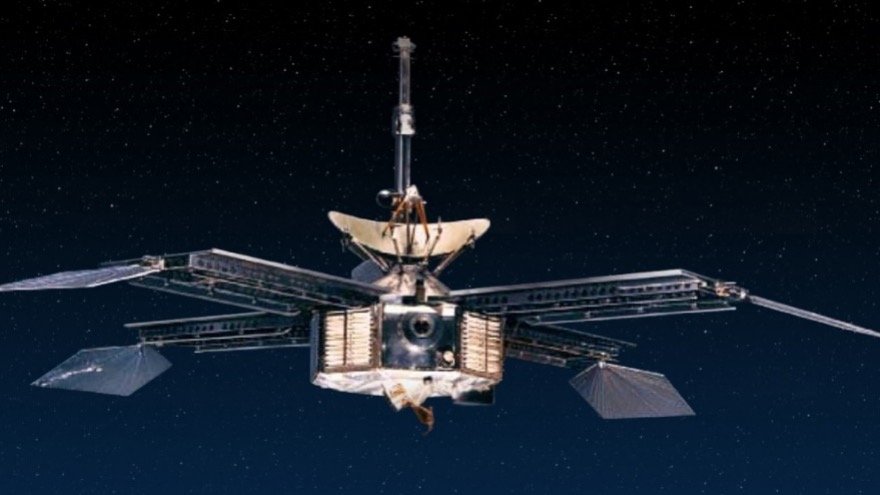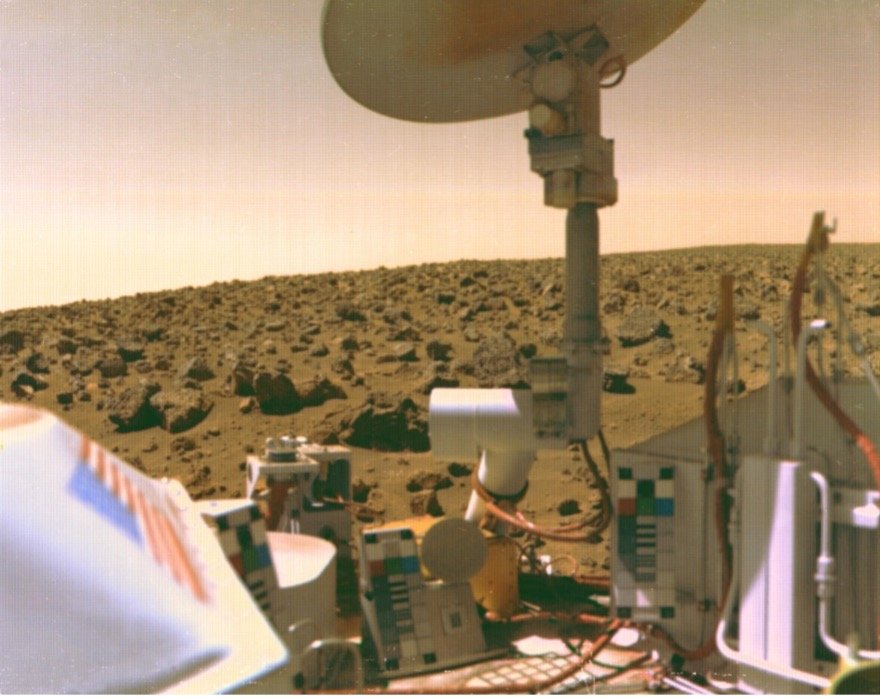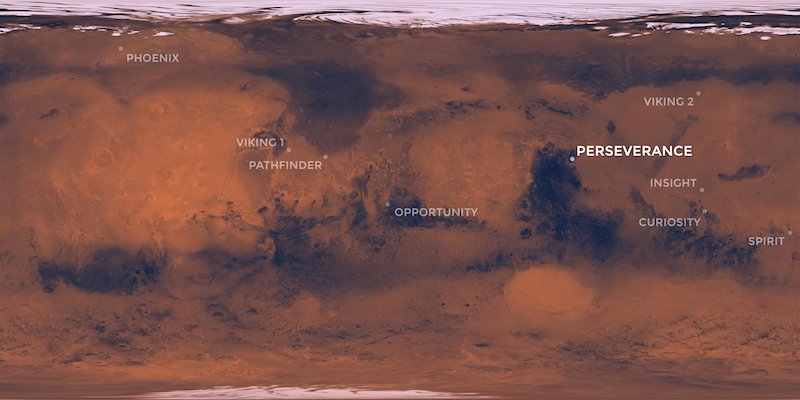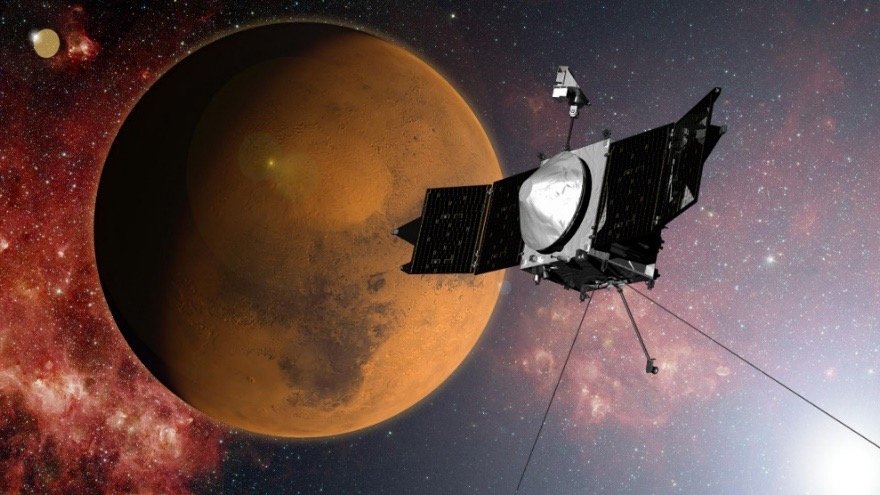
Red Planet Day: Did Mars Have a Global Flood?
What can we learn from Mars research?
Happy Red Planet Day! But right now, you might be thinking, is that really a holiday? YES! Well, sort of . . . (it’s considered an unofficial holiday). Nowadays, there seems to be some sort of holiday/celebration throughout the year for just about everything. I recently found out there’s even a National Coffee Day (September 29) and a National Chocolate Day (October 28)! (Now I just want a Mars chocolate bar . . . .)
November 28 marks the annual Red Planet Day—a day dedicated to the fourth planet from the sun, Mars, also known as the Red Planet.1
November 28 marks the annual Red Planet Day—a day dedicated to the fourth planet from the sun, Mars, also known as the Red Planet.1 For Christians, it can be a day to study and learn more about our neighboring planet that God created on day four of creation week. Or (even better!) come to the Creation Museum sometime soon and experience one of our Stargazer Night events, hosted by our resident astronomer Dr. Danny Faulkner, where you might catch a real view of the Red Planet (on a clear night) through one of the telescopes at the Johnson Observatory!2
A Brief History of Mars Exploration
What’s the reason for this date? In a nutshell, this date commemorates the day in 1964 when the interplanetary probe called Mariner 4 was launched by NASA to visit Mars. After a 228-day journey from Earth, it made history by becoming the first spacecraft to successfully do a Mars flyby.3 This mission also gave us the first close-up images of Mars.
Although the spacecraft only took a few photographs (covering only a very small amount of the martian surface), these were still astonishing to astronomers because the images revealed a lot of surprising geographical features, specifically impact craters, that astronomers were not expecting to find at that time. Back then, astronomers assumed Mars was more of an “earthlike” planet, so they weren’t expecting to find a planet that was more like our moon.
Five years later, in 1969, NASA launched two more Mars flyby missions, Mariner 6 and 7. Building off the success of Mariner 4, these missions provided much more coverage of the martian surface by sending back over 200 images (which were also higher quality than the Mariner 4 images).
Shortly after, in 1971, NASA sent Mariner 9, which became the first spacecraft to orbit Mars. This spacecraft ended up sending back thousands of good quality images, which then allowed scientists to compile a nearly complete map of the entire martian surface for the first time in history.
Then, in 1975, NASA sent two sets of orbiters and landers to Mars, Viking 1 and 2. Along with the amazing images that came from the orbiters, the landers provided some stunning images of the martian surface. The landers also had weather stations that collected science data for several years.
Over the last few decades since then, numerous spacecraft have been sent to Mars to gather even more exciting data about the Red Planet, including the following orbiters, landers, and rovers:4
| Year | Successful Missions (1996–Present) | Organization |
|---|---|---|
| 1996 | Mars Global Surveyor | NASA (USA) |
| 1996 | Mars Pathfinder & Sojourner | NASA (USA) |
| 2001 | Mars Odyssey Orbiter | NASA (USA) |
| 2003 | Mars Express Orbiter | ESA (Europe) |
| 2003 | MER Spirit & Opportunity Rovers | NASA (USA) |
| 2005 | Mars Reconnaissance Orbiter (MRO) | NASA (USA) |
| 2007 | Phoenix Lander | NASA (USA) |
| 2011 | Curiosity Rover | NASA (USA) |
| 2013 | Mars Orbiter Mission | ISRO (India) |
| 2013 | MAVEN Orbiter | NASA (USA) |
| 2016 | ExoMars Trace Gas Orbiter | ESA/Roscosmos |
| 2018 | InSight Lander | NASA (USA) |
| 2020 | Hope Orbiter | MBRSC (Emirates) |
| 2020 | Tianwen-1 Orbiter & Zhurong Rover | CNSA (China) |
| 2020 | Perseverance Rover & Ingenuity | NASA (USA) |
As of today, amazingly, there’s still a total of seven operational Mars orbiters (Odyssey, Express, MRO, MAVEN, ExoMars, Hope, Tianwen-1) and four operational landers/rovers (Curiosity, InSight, Zhurong, Perseverance) currently working on Mars.

NASA’s Perseverance Mars rover taking a “selfie” on September 10, 2021. Note: Perseverance uses a camera called WATSON (Wide Angle Topographic Sensor for Operations and eNgineering) on the end of its seven-foot-long robotic arm to take its “selfies.” [credit: NASA]
Looking ahead to the future, organizations are also continuing to develop additional Mars missions. For instance, NASA is looking ahead to launching a dual-spacecraft mission called the Escape and Plasma Acceleration and Dynamics Explorers (EscaPADE). The two spacecraft were originally supposed to launch this year (2022) but were delayed due to various problems. The next launch opportunity for this mission will likely be in 2024.
Why Bother Exploring Mars?
So, just from this short summary of Mars exploration missions, it’s obvious that people are very interested in exploring the Red Planet. And it definitely seems like we will continue to have a presence on Mars for many years to come. But, you might be wondering, why are people so interested in exploring this planet? Why bother spending so much time (and money) sending various spacecraft to a planet that’s millions of miles away from Earth?
Throughout history, people generally thought Mars was an “earthlike” planet that could sustain life, assuming it had a similar atmosphere, temperature, water, and so on. However, after sending spacecraft to survey the planet (starting with Mariner 4) astronomers quickly realized that Mars has very poor (hostile) conditions to support life.
Based on these observations, we’ve discovered Mars to be a desert planet that has a rocky surface covered with canyons, volcanoes, dry beds, and craters. It also has an atmosphere much thinner than Earth’s, mostly made up of carbon dioxide (CO2) and very little oxygen (less than 1%). This means we cannot breathe the air on Mars. And the temperature on Mars is very cold, with an average of about -80oF (that’s way below freezing!).

Image from Perseverance’s left navigation camera (look closely—you can see the Ingenuity helicopter hovering in flight) [credit: NASA]
Yet, based on observations from recent Mars missions, we’ve actually found evidence (such as river channels and shorelines) that water could have once flowed on Mars and possibly could even be present there today. For instance, the MRO found darkish streaks on the surface, which appeared to have ebbed and flowed over time, and detected signatures of hydrated minerals on the slopes around those streaks. The Spirit and Opportunity rovers have also found minerals on the surface that only form in water. Plus, the Mars Express orbiter has also found evidence that the ice cap covering the south pole of Mars dips and rises over time, which suggests liquid water could be present beneath the ice cap. And, on top of all that, scientists believe Mars was once subject to a global flood! (even though the existence of water has yet to actually be confirmed . . . more on that in a moment).
Hence, all this evidence has further motivated scientists to continue searching for evidence of water on Mars. That’s because many of them adhere to an evolutionary worldview (that says life evolved through random/chance processes), which means they reject the historical account in Genesis and instead rely on their own opinions to interpret any form of evidence, including the origins of Mars. In other words, they’ve elevated their own thoughts to supersede God’s Word (this is called humanism).
Since living things need water to survive, they believe finding evidence of water means there could be (or could have been) life on Mars.
Since living things need water to survive, they believe finding evidence of water means there could be (or could have been) life on Mars. This is important to them because, based on their worldview, if life evolved on Earth (which it didn’t), then life could have evolved elsewhere in the universe, even somewhere in our own solar system, given the “right” conditions.
Also, in a general sense, evolutionists believe Earth is no different than any other planet (which obviously contradicts God’s Word; see Isaiah 45:18). Thus, whenever they discover any shred of possible “evidence” of life on Mars, they are desperate to use that to justify their evolutionary (secular) beliefs. For instance, on a past Answers News segment, we covered an article titled “Dog door on Mars found by Curiosity rover is a rocky doorway into the ancient past,” which (hilariously), set the internet ablaze with discussions on possible martian life.5
So, because of their religious beliefs about the past, the same scientists who believe there was a global flood on Mars—a planet with no standing water—(foolishly) reject the truth of a catastrophic flood (Genesis 6–9) that actually did cover the whole Earth—our planet, 70% of which is currently covered in water and contains enough water to flood over 1.5 miles deep! Of course, that’s not to say these scientists are not intelligent. But rather it further demonstrates how every person will always interpret any sort of evidence through their worldview.6
And I can personally attest to this point. One of the Mars missions that I used to be involved with was the MAVEN (Mars Atmosphere and Volatile EvolutioN) mission, part of the Guidance, Navigation & Control (GNC) operations. My job was to control and monitor the GNC systems onboard the spacecraft. The MAVEN mission had some great observational science aspects (science that is observable, testable, and repeatable) related to studying the martian atmosphere—as it exists today in the present—such as collecting data on the rate of gases escaping the atmosphere into space and seeing how the solar wind7 interacts (strips away) gas particles in the upper atmosphere.
But, from my own experience dealing with secular scientists on a weekly basis, the data was normally interpreted (again, via their evolutionary worldview) in order to better understand the “origins” of Mars and its atmosphere in terms of cosmological evolutionary assumptions. In other words, they continually offered scenarios (stories) to try to explain what happened in Mars’ past, based on (false) assumptions about the past (this is a logical fallacy called begging the question). Needless to say, it was a challenging experience to be a biblical (young-earth) creationist working on this program.8
The MAVEN program is a prime example that demonstrates the importance of knowing the difference between observational and historical science. Using the same data (in the present), biblical creationists—starting with God’s Word as the ultimate authority—would reach different conclusions about the past. As we frequently say here at AiG, “Wrong assumptions lead to wrong conclusions.”
Should Christians Support Exploring Mars?
Obviously, as Christians, we shouldn’t be supporting Mars exploration missions using those same types of evolutionary goals. But are there any biblical reasons to support these types of Mars missions? And is it even financially wise to pursue missions that cost millions (or even billions) of dollars? We’ll first address the latter concern.
There’s no doubt that launching spacecraft (especially with humans onboard) into space involves significant monetary expenses and risks.9 Currently, the costs of sending unmanned spacecraft to Mars are small fractions compared to sending humans on the same mission. For example, the overall cost to send a rover to Mars can be roughly $1–2 billion (give or take), whereas the cost estimates of a manned mission would range upward of $500 billion. Of course, the drawback is that unmanned spacecraft (such as probes and rovers) will never exhibit the real curiosity or wonder of human explorers. But obviously, for the time being, it’s probably wise that we continue to prioritize sending unmanned missions to Mars rather than manned missions.
![Atlas V rocket lifting off from LC-41 at CCAFS on July 30, 2020, carrying the Perseverance rover and Ingenuity helicopter [credit: NASA]](https://assets.answersingenesis.org/img/articles/2022/11/atlas-v.jpg)
Atlas V rocket lifting off from LC-41 at CCAFS on July 30, 2020, carrying the Perseverance rover and Ingenuity helicopter [credit: NASA]
God does repeatedly tell us in his Word to take care of those in need, so we shouldn’t downplay the importance of this matter. However, we should also realize that space exploration is not a black hole (pun intended) of infinite funding,10 meaning companies in the space industry (just like any other company) still need to make a profit in order to pay their employees so they can feed and clothe their own families (1 Timothy 5:8).
In fact, the current space industry regularly supplies a significant number of jobs and commercial stimulation in the economy (these, by the way, are positive biblical concepts). So instead of questioning or criticizing how these groups use their resources, we should examine our own assets that have been given to us by our gracious God (i.e., let’s focus more on how often we charitably give to those in need).
But if the costs involved with space exploration continue to decrease (which I think is likely, assuming the recent exponential increase in technology continues moving forward), then I believe we should focus on launching more Mars exploration missions soon and even potentially colonize Mars! But again, this is assuming space travel becomes much more feasible in the near future. (By the way, here’s a really easy way to colonize Mars—:M:a:r:s:.)
Are We There Yet?
Also, compared to every other body in our solar system (besides the moon), Mars is the most ideal candidate for any sort of human exploration endeavor. In fact, as of recently, the prospect of one day colonizing Mars has actually been quickly transitioning from the realm of science fiction into actual reality.11
But before that happens, the risk to human life needs to first be greatly minimized by (at least) having ultra-reliable life-support systems and fully protective housing structures on the surface of Mars. These efforts must be completely worked out before attempting any sort of colonization effort.
Biblically speaking, life is precious and wonderfully made in the image of God (Genesis 1:27; Psalm 139:14) so it must be protected to the best of our ability. And this, by the way, is something secular scientists cannot say—having no objective standard to protect human life—which is also why Christians ought to be the ones leading the charge on a potential Mars colonization endeavor.
Only through the biblical worldview do we have an objective standard—standing on God’s Word as the foundation—when establishing any kind of moral/ethical practices and laws for a new Mars colony.12 Rather than rely on fallible human governments to decide which specific set of “laws” to adopt (i.e., by what standard?), the colony would need to stand on God’s infallible laws as the moral standard in order to survive (and thrive) in the new world.
And note, this should not be seen as an abandonment or rejection of the world that God has given to us. Because of God’s omnipresence (being completely present everywhere in the universe), Christians can glorify God in the same effective manner on Mars as on Earth. Plus, the temple of the Holy Spirit resides inside every Christian, regardless of their physical location (1 Corinthians 3:16). Thus, spiritually speaking, Christians can genuinely worship and glorify God anywhere in the universe.
What’s the Biblical Response?
Simply put, God made us as very curious creatures that are “hardwired” to explore all our surroundings, even at the risk of our lives. Of course, we don’t see any direct revelation regarding space exploration from the Bible.13 But I do believe that exploring all of God’s creation to learn more about how it works, what resources we can use for our benefit, and how it reveals the Creator is certainly implied as part of our dominion mandate (see Genesis 1:26–28; Job 12:7–10; Psalm 8; and Romans 1:20). That is, I believe exploring outer space to study all of God’s creation is not only permissible but also encouraged.
Psalm 19:1–2 says, “The heavens declare the glory of God, and the sky above proclaims his handiwork. Day to day pours out speech, and night to night reveals knowledge,” meaning we have the wonderful privilege of seeing God’s glory reflected in the heavens. So why wouldn’t we want to explore all of God’s amazing creative works?
In other words, outer space is not to be disregarded or avoided. Rather, like many of the great Christian astronomers of the past, such as Johannes Kepler, have stated, we should study and explore the heavens! But it needs to be with the primary goal of admiring the handiwork and glory of God, giving thanks to him for creating and sustaining our universe (Colossians 1:16–17; Hebrews 1:1–3).
So, on this Red Planet Day, let’s enjoy and celebrate this (unofficial) holiday for the cool and exciting Red Planet created by God, all to his glory! (1 Corinthians 10:31).
But most importantly, these exciting possibilities of space exploration should really point us to Jesus, who not only is the Creator (John 1:1–3) of the entire universe but also our perfect Savior and Redeemer (2 Corinthians 5:19).
But most importantly, these exciting possibilities of space exploration should really point us to Jesus, who not only is the Creator (John 1:1–3) of the entire universe but also our perfect Savior and Redeemer (2 Corinthians 5:19). If you haven’t confessed that Jesus Christ is Lord (Romans 10:9), then the call of the gospel is to repent (turn from your sins) and put your trust completely in Christ, and you will be saved from the wrath of God to come (Romans 5:9). None of us know when we’re going to die, so this truly is a time-sensitive message. Turn to Christ today for eternal life (John 3:16) and give the glory to him who makes space exploration possible by the mighty word of his power!
Footnotes
- Mars is actually more of a butterscotch color when examined up close (as seen from an orbiter or lander). In fact, depending on the specific landscape/area, there’s actually a wide range of brown/tan colors on the surface of Mars. The reason it looks “reddish” to us is because of the abundance of iron oxide (rust) on the martian surface that gets swept up into its atmosphere.
- You can learn more and sign up for upcoming events here: https://creationmuseum.org/events/workshops/stargazers-night/.
- A Mars “flyby” means the spacecraft does not go into orbit or land on the surface. Rather, it does a “close” approach (flying by the planet) and then keeps going farther into the solar system.
- An “orbiter” is a spacecraft that orbits around the planet. A “lander” is a type of spacecraft that physically touches down on the surface but does not move around. A “rover” is a vehicle that lands on the surface and can move around to explore the planet.
- It was later confirmed by NASA that the “door” is just a natural “open fracture” in the bedrock. Nonetheless, the point is that people tend to get into a frenzy over even the slightest (unconfirmed) sign of possible life on other planets, which again shows their blind faith (faith with no credible evidence) in evolution and the desperate attempt of sinful man to reject the (obvious) evidence of our Creator (Romans 1).
- That is, no one can ever just approach the evidence in a “neutral” fashion (i.e., there’s no such thing as “let the evidence speak for itself”). Every person has a set of beliefs that forms their worldview and how they interpret data. So it’s not a question of “whether you have faith,” but rather it’s a question of “in what (or whom) have you placed your faith?” Have you built your faith on the solid rock of God’s Word or the shifting sands of man’s opinions?
- The solar wind is a stream of energized (charged) particles that continually flows outward from the sun all throughout the solar system.
- There were actually a handful of Christians that I did work alongside on this program. However, all of them adhered to some sort of compromised (old-earth) biblical position, trying to reinterpret the historical account of Genesis to fit long ages (“millions of years”) into the text.
- For instance, the Viking missions cost $1.06 billion, which when adjusted for inflation remains NASA’s most expensive robotic planetary science mission of all time.
- The annual budget for NASA and other space programs is actually minuscule compared to the rest of the US government spending (less than 1%). https://www.planetary.org/space-policy/nasa-budget
- For instance, SpaceX is currently developing realistic plans to eventually colonize Mars, possibly even by the end of this decade. https://www.spacex.com/human-spaceflight/mars
- This is also important because, in 1967, the UN created the Treaty on Principles Governing the Activities of States in the Exploration and Use of Outer Space, including the Moon and Other Celestial Bodies, stating that “the exploration and use of outer space shall be carried out for the benefit and in the interests of all countries and shall be the province of all mankind,” which means there will most certainly be political struggles with legislating any new laws on Mars. https://www.unoosa.org/oosa/en/ourwork/spacelaw/treaties/introouterspacetreaty.html
- Also note: Christians should avoid using verses like Psalm 115:16 to try to say that we are prohibited from any form of space travel. In context, this verse has nothing to do with whether or not we can/should explore other bodies in the solar system.
Recommended Resources

Answers in Genesis is an apologetics ministry, dedicated to helping Christians defend their faith and proclaim the good news of Jesus Christ.
- Customer Service 800.778.3390
- © 2024 Answers in Genesis








![Artistic concept depicting astronauts and human habitats on Mars [credit: NASA]](https://assets.answersingenesis.org/img/articles/2022/11/mars-base.jpg)






